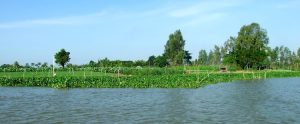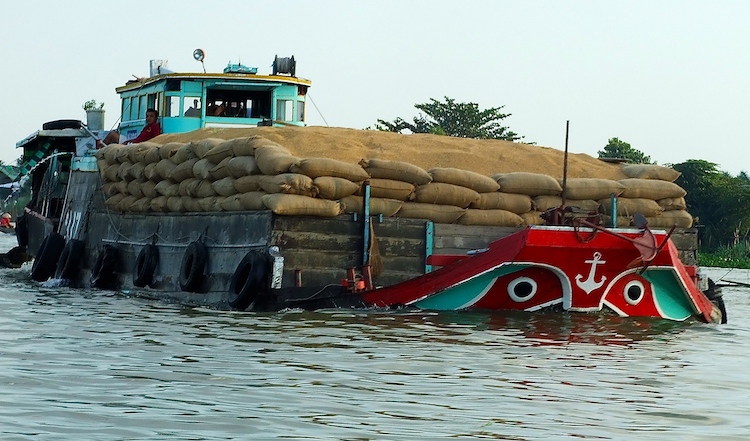By Le Thanh Binh
HO CHI MINH CITY | 3 January 2024 (IDN) — The Mekong Delta in South Vietnam has been the country’s rice granary for generations, feeding more than 20 million people today. But climate change resulting in droughts and salinity of the river-fed waters is now threatening food security. (P27) French | Hindi | Indonesian | Japanese | Thai
The Mekong River originates in China and flows through 6 Asian nations—China, Myanmar, Thailand, Laos, Cambodia, and Vietnam—before flowing into the East China Sea. Today, Vietnam, a major rice-exporting country, depends mainly on the Mekong River for its rice cultivation.
But at the present stage, many dams built in China, Laos, and Cambodia are limiting water sources from upstream, saltwater intrusion due to rising sea levels, and the El Niño drought phenomenon also causes hefty losses of water for cultivation.
In the last decade, the Mekong Delta has endured two severe droughts in 2016 and 2020, as well as the previous year’s poor water season, which has dramatically affected the lives and production of farmers in the Mekong Delta and the overall Vietnamese economy.
In September 2023, according to information presented at a conference related to floods, drought, and saltwater intrusion in the southern region of Vietnam, organized by the General Department of Hydrometeorology in Ben Tre province, currently, the water level at Cambodia’s Great Lake Tonle Sap is rising slowly, at approximately the same level as in 2015 and about one meter lower than the average for many years.
Tonle Sap is a great lake in Cambodia formed by the Mekong River waters, a lake for half a year and paddy fields for the other half. A phenomenal reverse flow of Mekong currents and water creates this. Tonle Sap’s water level rises slowly until mid-October, then gradually decreases.
In September 2023, the Tonle Sap water levels were 30 percent smaller than the average of many years. By the end of the year, the water level was predicted to be 1.3-1.6 meters lower than the average for many years. The total flow volume in the dry season months from the upper Mekong (in Cambodia) to the downstream and the Mekong Delta is likely to be 20-25 percent short compared to the average of many years.
El Niño is forecast to continue until April and May
In addition, El Niño is forecast to continue until April and May this year, with strong to powerful intensity like in 2016. The average temperature until the dry season is 0.5-2 degrees Celsius, higher than other years. The rainy season in the Mekong Delta ended early (before mid-November), and the total rainfall for the year was short compared to previous years.
Calculation results show that salinity in rivers during this year’s dry season was mainly higher than the average level of many years and higher than the same period in 2022. Specifically, it is forecast that the highest salinity on the subsidiary Tien and Hau rivers in mid-March this year will be 3- 5 deg/liter higher than the average for many years.
Bui Van Tham, Deputy Director of the Department of Agriculture and Rural Development of Ben Tre province, said in September that saltwater intrusion would affect the locality in about two months. Each year, saline intrusion lasts about 3 months on average, but there are extreme years when saline drought lasts up to 6 months.
In the 2019–2020 dry season, drought and saltwater intrusion came early, penetrated deeply, and lasted a long time, causing more than 5,000 hectares of winter-spring rice to die, over 27,000 hectares of fruit trees, and more than 2,000 hectares of aquaculture were affected, with a total loss of more than 1,600 billion VND (USD 135.9 m)
Tham recommends that hydrometeorological reports during severe salinity should be released early, specifically about when and where fresh water is available for people to reserve. Localities must be supported with technology, equipment, automatic salinity, and water level monitoring systems to increase warnings and limit damage.
Previously, management units and experts said that the floods were small, the rainy season ended early, the El Niño phenomenon lasted long, and the Mekong Delta was at risk of severe drought – similar to the 2015 – 2016 dry season that affected people.
In the dry season 7 years ago, a prolonged drought caused 600,000 people here to lack running water, and 160,000 hectares of land became saline, causing damage of more than 5,500 billion VND (USD 226.6 m).
In the 2023-2024 Winter-Spring rice crop, the Mekong Delta region sowed 1.47 million hectares, with an estimated output of 10.6 million tons; this is a decrease compared to the same period last year (1.5 million hectares and more than 11 million tons of rice).[1]
The Ministry of Agriculture and Rural Development assessed that 108,000 hectares of shrimp and rice production in the Ca Mau peninsula are likely to lack water. In the case of saltwater intrusion like the 2015-2016 dry season, about 60,000 hectares of Winter-Spring rice and 43,000 hectares of fruit trees in Long An, Tien Giang, Ben Tre, Tra Vinh, and Soc Trang provinces lack water.

The Ministry of Agriculture and Rural Development of Vietnam has proposed many short-term and long-term solutions to support farmers in overcoming the harmful effects of drought and salinity on agricultural production.
These include actively creating freshwater storage works for daily life and production and building salinity prevention works at river mouths to limit the encroachment of salinity boundaries.
Tran Hoang Nhat Nam, Deputy Director of the Tien Giang Department of Agriculture and Rural Development, says the province will proactively deploy drought and saltwater intrusion prevention work soon.
The locality has constructed six culverts connecting the Tien River to ensure salinity prevention for fruit-growing areas in the west. “In the east, the Go Cong freshening area will apply measures to prevent salinity, like decanting or pumping to replenish water every year,” Nam said.
In addition, Tien Giang province is rushing construction to complete a saltwater prevention culvert on the Nguyen Tan Thanh canal (in Chau Thanh district), located 420 meters from the Tien River. The project has a total investment of more than 518 billion VND (USD 21.3 million), starting in mid-November 2022. When completed, it will prevent salinity and provide domestic water and irrigation for 1.1 million people and 128,000 hectares of production land in two Tien Giang and Long An provinces.
Le Tu Do, Director of the Mekong Delta branch of the Southern Irrigation Exploitation Company Limited, said the unit is monitoring the salinity situation at locations inside and outside the Cai Lon – Cai Be sewer (in Kien Giang province).
This is the largest irrigation project in the Mekong Delta, with an investment capital of 3,300 billion VND (USD135.9 m), with the role of controlling and regulating water for nearly 400,000 hectares of land in the Ca Mau peninsula of the Mekong Delta and was built quickly during the period.
During the two years of the Covid-19 epidemic, the task of preventing saltwater intrusion was best achieved. “By mobilizing all resources along with the efforts of the Government of Vietnam and the people of the Mekong Delta region, we will overcome difficulties to achieve bumper harvests,” says Tu Do. [IDN-InDepthNews]
Photo 1: Vietnamese rice harvests being transported by barge on the Mekong River. Credit: Kalinga Seneviratne
Photo 2: Rice fields on the banks of the Mekong River in South Vietnam. Credit: Kalinga Seneviratne
[1] https://vov.vn/kinh-te/vu-lua-dong-xuan-vung-dbscl-se-xuong-giong-khoang-15-trieu-hecta-post957500.vov; 22/09/2022 MARD workshop at Can Tho City “Summary of production for the Fall-Winter crop and the 2022 Summer crop; Implementing production plans for the 2022-2023 Winter-Spring crop in Southeast provinces and cities and the Mekong Delta region”.












